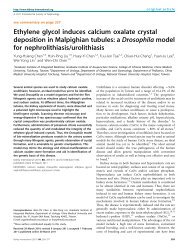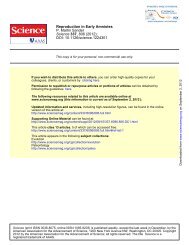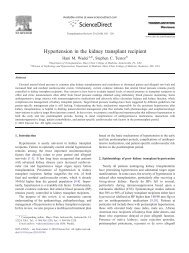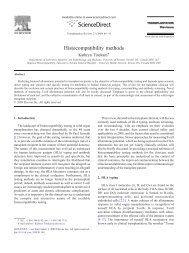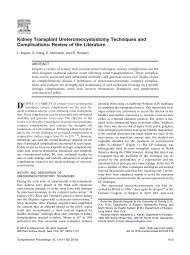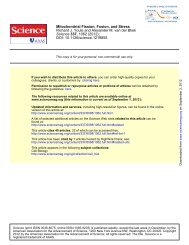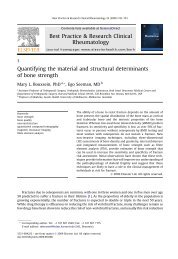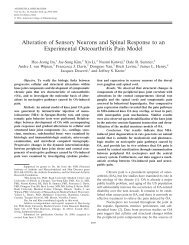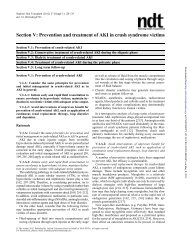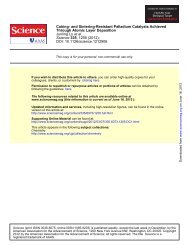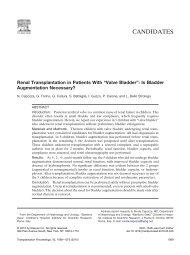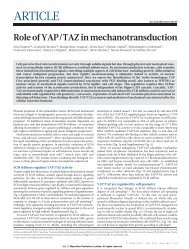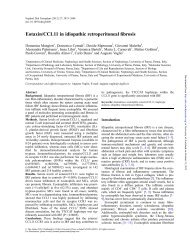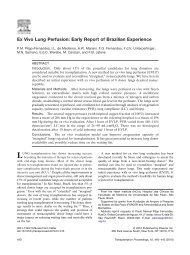The contribution of Asian researchers to the field of rheumatology
The contribution of Asian researchers to the field of rheumatology
The contribution of Asian researchers to the field of rheumatology
Create successful ePaper yourself
Turn your PDF publications into a flip-book with our unique Google optimized e-Paper software.
eviews<br />
1. Zeng, Q. Y. et al. rheumatic diseases in China.<br />
Arthritis Res. <strong>The</strong>r. 10, r17 (2008).<br />
2. Omurzakova, N. A. et al. High incidence <strong>of</strong><br />
rheumatic fever and rheumatic heart disease in<br />
<strong>the</strong> republics <strong>of</strong> Central Asia. Int. J. Rheumatic<br />
Dis. 12, 79–83 (2009).<br />
3. Yazici, H., Fresko, I. & Yurdakul, S. Behcet’s<br />
syndrome: disease manifestations,<br />
management, and advances in treatment. Nat.<br />
Clin. Pract. Rheuma<strong>to</strong>l. 3, 148–155 (2007).<br />
4. Osame, M. et al. HTLV‑I associated myelopathy, a<br />
new clinical entity. Lancet 1, 1031–1032 (1986).<br />
5. Nishioka, K. et al. Chronic inflamma<strong>to</strong>ry<br />
arthropathy associated with HTLV‑I. Lancet 1,<br />
441 (1989).<br />
6. Mochizuki, M. et al. Uveitis associated with<br />
human T‑cell lymphotropic virus type I. Am. J.<br />
Ophthalmol. 114, 123–129 (1992).<br />
7. Maruyama, I., Mori, S., Kawabata, M. &<br />
Osame, M. Bronchopneumonopathy in HTLV‑1<br />
associated myelopathy (HAM) and non‑HAM<br />
HTLV‑1 carriers [Japanese]. Nihon Kyobu Shikkan<br />
Gakkai Zasshi 30, 775–779 (1992).<br />
8. Nakagawa, M. et al. HTLV‑I‑associated<br />
myelopathy: analysis <strong>of</strong> 213 patients based on<br />
clinical features and labora<strong>to</strong>ry findings.<br />
J. Neurovirol. 1, 50–61 (1995).<br />
9. Takayanagi, H. Osteoimmunology: shared<br />
mechanisms and crosstalk between <strong>the</strong> immune<br />
between <strong>the</strong> in vivo and in vitro results can be attributed<br />
<strong>to</strong> <strong>the</strong> presence <strong>of</strong> multiple antiapop<strong>to</strong>tic processes and/or<br />
phenomena in <strong>the</strong> rheuma<strong>to</strong>id syno vium. For instance,<br />
invading T cells have been found <strong>to</strong> possess defective FasL<br />
expression, which possibly accounts for <strong>the</strong> ineffec tive<br />
clearance <strong>of</strong> FasR-expressing cells. 55 In addition, cy<strong>to</strong>kines<br />
derived from synoviocytes and stromal cells, including<br />
TNF and IL-1, protect synovi ocytes involved in RA from<br />
Fas-induced apop<strong>to</strong>sis. 56<br />
<strong>The</strong>se fac<strong>to</strong>rs might account for <strong>the</strong> capability <strong>of</strong><br />
T cells involved in RA <strong>to</strong> escape apop<strong>to</strong>sis via close<br />
interactions with synoviocytes. 57 Moreover, synovial<br />
macrophages and fibroblasts in RA-affected joints<br />
upregulate endo genous inhibi<strong>to</strong>rs <strong>of</strong> <strong>the</strong> Fas pathway,<br />
including c-FLIP. 58 Thus, multiple pathways—both intracellular<br />
and extracellular—impair Fas-induced apop<strong>to</strong>sis<br />
in RA-affected joints. <strong>The</strong> above observations strongly<br />
suggest that modulation <strong>of</strong> <strong>the</strong> Fas pathway in vivo could<br />
be a useful <strong>the</strong>rapeutic strategy.<br />
More-direct evidence for <strong>the</strong> involvement <strong>of</strong> <strong>the</strong> Fas<br />
pathway in arthritis was obtained in mouse studies—<br />
many <strong>of</strong> which were conducted in Japan—in which <strong>the</strong><br />
agonistic apop<strong>to</strong>sis-inducing antibodies <strong>to</strong> FasR were<br />
shown <strong>to</strong> be efficacious in treating arthritis. 59 Similar<br />
findings have also been confirmed in humanized experimental<br />
models. 60 Thus, current evidence suggests that<br />
activation <strong>of</strong> <strong>the</strong> agonistic Fas pathway can be considered<br />
as a potentially useful treatment strategy for <strong>the</strong> treatment<br />
<strong>of</strong> RA and o<strong>the</strong>r inflamma<strong>to</strong>ry arthritides. Indeed, clinical<br />
trials <strong>of</strong> antibody <strong>to</strong> FasR, administered via intra-articular<br />
injection, in patients with RA are currently underway.<br />
Preliminary results <strong>of</strong> a Belgian phase I clinical trial indicate<br />
that this <strong>the</strong>rapy is safe and effective, even at very low<br />
antibody concentrations. 61 In Japan, a multicenter, phase I<br />
trial in more than 140 patients is in progress, with detailed<br />
results expected soon.<br />
Conclusions<br />
Some unique immunological disease entities, <strong>the</strong> study <strong>of</strong><br />
which have influenced our understanding <strong>of</strong> <strong>the</strong> concepts<br />
involved in o<strong>the</strong>r rheumatic disorders, have been discovered<br />
in <strong>the</strong> <strong>Asian</strong> region. Research on <strong>the</strong> pathogenesis<br />
<strong>of</strong> <strong>the</strong>se diseases has greatly increased <strong>the</strong> understanding<br />
<strong>of</strong> immune-mediated disorders. Fur<strong>the</strong>rmore, novel<br />
discoveries made by <strong>Asian</strong> re searchers in conventional<br />
scientific disciplines, such as <strong>the</strong> discovery <strong>of</strong> T REG cells<br />
and <strong>the</strong> antiapop<strong>to</strong>tic molecule synoviolin, and <strong>the</strong><br />
development <strong>of</strong> <strong>the</strong> new discipline <strong>of</strong> osteoimmunology,<br />
have opened up new research avenues in rheuma<strong>to</strong>logy.<br />
<strong>Asian</strong> rheuma<strong>to</strong>logists have also success fully applied <strong>the</strong><br />
findings <strong>of</strong> labora<strong>to</strong>ry research <strong>to</strong> clinical practice and<br />
developed new strategies, such as <strong>to</strong>cilizumab and antibodies<br />
<strong>to</strong> FasR. Clinical trials are currently underway <strong>to</strong><br />
confirm <strong>the</strong> safety and efficacy <strong>of</strong> <strong>the</strong>se <strong>the</strong>rapies.<br />
Review criteria<br />
and bone systems. Nat. Rev. Immunol. 7,<br />
292–304 (2007).<br />
10. Sakaguchi, S., Sakaguchi, N., Asano, M., I<strong>to</strong>h, M.<br />
& Toda, M. Immunologic self‑<strong>to</strong>lerance<br />
maintained by activated T cells expressing IL‑2<br />
recep<strong>to</strong>r alpha‑chains (CD25). Breakdown <strong>of</strong> a<br />
single mechanism <strong>of</strong> self‑<strong>to</strong>lerance causes<br />
various au<strong>to</strong>immune diseases. J. Immunol. 155,<br />
1151–1164 (1995).<br />
11. Sakaguchi, S., Yamaguchi, T., Nomura, T. &<br />
Ono, M. regula<strong>to</strong>ry T cells and immune<br />
<strong>to</strong>lerance. Cell 133, 775–787 (2008).<br />
12. Yagishita, N., Yamasaki, S., Nishioka, K. &<br />
Nakajima, T. Synoviolin, protein folding and <strong>the</strong><br />
maintenance <strong>of</strong> joint homeostasis. Nat. Clin.<br />
Pract. Rheuma<strong>to</strong>l. 4, 91–97 (2008).<br />
13. Yamada, r. & Yamamo<strong>to</strong>, K. Mechanisms <strong>of</strong><br />
disease: genetics <strong>of</strong> rheuma<strong>to</strong>id arthritis—<br />
ethnic differences in disease‑associated genes.<br />
Nat. Clin. Pract. Rheuma<strong>to</strong>l. 3, 644–650 (2007).<br />
14. Nishimo<strong>to</strong>, N. & Kishimo<strong>to</strong>, T. Interleukin 6:<br />
from bench <strong>to</strong> bedside. Nat. Clin. Pract.<br />
Rheuma<strong>to</strong>l. 2, 619–626 (2006).<br />
15. Behçet, H. Uber rezidivierende, aphthose, dürch<br />
ein Virus verursachte Geshwure am Munde, am<br />
Auge und an den Genitalien. Derma<strong>to</strong>logische<br />
Wochenschrift 36, 1152–1157 (1937).<br />
16. Verity, D. H., Marr, J. e., Ohno, S., wallace, G. r. &<br />
Stanford, M. r. Behçet’s disease, <strong>the</strong> Silk road<br />
Data for this review were obtained by searching <strong>the</strong><br />
PubMed database for english and Japanese‑language<br />
papers, published from 1960 onwards, using <strong>the</strong><br />
following search terms: “Asia”, “rheuma<strong>to</strong>logy”,<br />
“HTLV”, “rheuma<strong>to</strong>id arthritis”, “au<strong>to</strong>immune disease”,<br />
“Behçet”, “Takayasu’s arteritis”, “Kawasaki disease”,<br />
“osteoimmunology”, “Treg”, “Foxp3”, “synoviolin”,<br />
“ethnic”, “IL‑6”, “Fas”, “FasL”, “apop<strong>to</strong>sis” and<br />
“cy<strong>to</strong>kine”. Additional studies were identified from <strong>the</strong><br />
abstracts <strong>of</strong> <strong>the</strong> American College <strong>of</strong> rheuma<strong>to</strong>logy<br />
Scientific Meetings.<br />
and HLA‑B51: his<strong>to</strong>rical and geographical<br />
perspectives. Tissue Antigens 54, 213–220<br />
(1999).<br />
17. Hatemi, G. et al. <strong>The</strong> pustular skin lesions in<br />
Behcet’s syndrome are not sterile. Ann. Rheum.<br />
Dis. 63, 1450–1452 (2004).<br />
18. Gul, A. Behcet’s disease as an au<strong>to</strong>inflamma<strong>to</strong>ry<br />
disorder. Curr. Drug Targets Inflamm. Allergy 4,<br />
81–83 (2005).<br />
19. Numano, F. <strong>The</strong> s<strong>to</strong>ry <strong>of</strong> Takayasu arteritis.<br />
Rheuma<strong>to</strong>logy (Oxford) 41, 103–106 (2002).<br />
20. Koide, K. Takayasu arteritis in Japan. Heart<br />
Vessels Suppl. 7, 48–54 (1992).<br />
21. Arend, w. P. et al. <strong>The</strong> American College <strong>of</strong><br />
rheuma<strong>to</strong>logy 1990 criteria for <strong>the</strong><br />
classification <strong>of</strong> Takayasu arteritis. Arthritis<br />
Rheum. 33, 1129–1134 (1990).<br />
22. Kimura, A., Kitamura, H., Date, Y. & Numano, F.<br />
Comprehensive analysis <strong>of</strong> HLA genes in<br />
Takayasu arteritis in Japan. Int. J. Cardiol. 54<br />
(Suppl.), S61–S69 (1996).<br />
23. Seko, Y. et al. Perforin‑secreting killer cell<br />
infiltration and expression <strong>of</strong> a 65‑kD heat‑shock<br />
protein in aortic tissue <strong>of</strong> patients with<br />
Takayasu’s arteritis. J. Clin. Invest. 93, 750–758<br />
(1994).<br />
24. Huang, w. C. et al. epidemiologic features <strong>of</strong><br />
Kawasaki disease in Taiwan, 2003–2006.<br />
Pediatrics 123, e401–e405 (2009).<br />
110 | FEBRUARY 2010 | volUmE 6 www.nature.com/nrrheum<br />
© 20 10<br />
Macmillan Publishers Limited. All rights reserved



